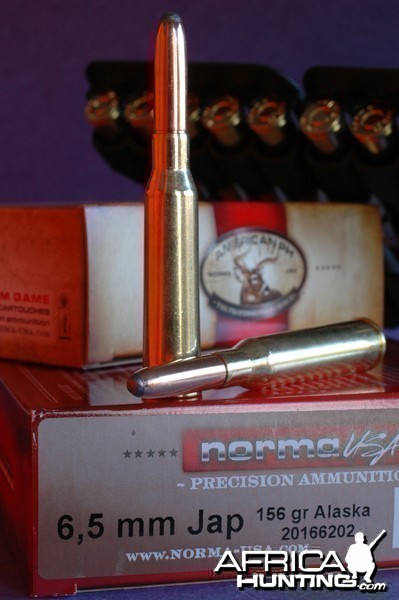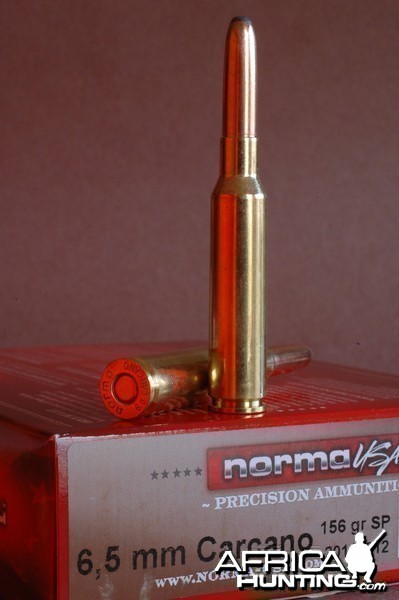USAN
AH fanatic
by Wayne van Zwoll

Two cartridges used during World War II get far less attention now than they did when surplus infantry rifles chambered for them flooded the North American market. The 6.5x50 Japanese Arisaka and the 6.5x52 Italian Mannlicher-Carcano don’t quite match the more celebrated (and still popular) 6.5x55 Swedish ballistically, but many thousands of Arisaka and Carcano rifles are still floating around. Owners no doubt applaud Norma for keeping these two 6.5s in its line – and for endowing them with reloadable, Boxer-primed cases. As issued during military service, both had Berdan priming, with dual flash-holes in cases with integral anvils. Depriming was an exercise in hydraulics, if you didn’t have a special hook. The Arisaka was designed with a Berdan primer of a size never available to handloaders.
The 6.5 Arisaka and 6.5 Carcano cases measure roughly 2 inches in length, like the .30-30, .303 Savage, .32 Special and .308 Winchester. While the Arisaka’s semi-rimmed hull is .471 across the rim (behind a .455 web) and conveniently fits the bolt faces of rifles for the .30-06 and .308 families (.473 rims), Italy hewed to a rimless design with a .445 web and .448 rim. Powder capacities of these 6.5s are similar. The infantry load for the Arisaka featured a 139-grain bullet at about 2,500 fps. The Carcano in uniform drove a 152-grain bullet at about 2,300. Norma loads both with its 156-grain Alaska softpoint.
Developed in 1897 (evidently with little if any help from Col. Arisaka), the 6.5 Arisaka was a hop ahead of the crude rifle chambered for it: the Type 30, a variant of the old Murata bolt-action. Limited production of its successor, the Type 35, began in 1902. Then in 1905, Japan came up with the Type 38 rifle, a stronger Mauser-style turn-bolt that endured both world wars. It can tap the Arisaka cartridge’s potential. Handloaders using Norma cases can wring 3,000 fps from 120-grain bullets, 2,650 from 140s. While nominal bullet diameter is .263, the .264 bullets now standard for 6.5mm bores work fine. The 1-in-7.9 rifling twist of Type 38 rifles is sharp enough to stabilize bullets to the top of the 6.5 weight range.
Note: the Arisaka Type 38 rifle is indistinguishable at a glance from smoothbore Type 38 training models with welded or cast or forged-iron receivers. Training rifles should never be fired with live ammunition!
Italy’s 6.5 Carcano is even older than the Arisaka, dating to 1891. The bolt-action Mannlicher-Carcano shows the influence of Ferdinand Ritter von Mannlicher, but the bolt is more like a Mauser’s, with twin front locking lugs. The rifle, developed by Lt. Col. Salvatore Carcano and Col. G. Parravicino in the Tonino (Turin) Arms Factory, is the only smokeless military arm produced in quantity with gain-twist rifling. That is, twist rate increases from breech to muzzle, to keep pressures in check during launch while stabilizing long bullets – without a compromise in velocity. Standard twist for the Carcano is 1-in-19.3 to 1-in-8.3. Oddly enough, nominal Carcano bullet diameter is .265; obviously .264s suffice.
Infamous as the rifle used to assassinate President John F. Kennedy, the Carcano sold during that era for very low prices. So did the Arisaka. While neither appeals to sophisticates as the basis for custom sporters, both have been converted to serviceable hunting rifles. These short 6.5mm cartridges excel as light-recoiling options for deer-size game. Norma’s heavy, round-nose Alaska softpoint is also ideal for black bears, wild hogs and even bigger game in cover. Started at a leisurely 2,100 fps, it brings 1,000 foot-pounds of energy to 200 yards – point-blank range with a 150-yard zero. Having used the slightly more potent 6.5x55 Swedish on elk, I’ve no doubt the “Jap” and Carcano will also down this tough deer of the Rockies, albeit the world is full of better elk rounds.
Best powder picks for handloading these mild 6.5s depend on bullet weight. Medium-slow fuels suffice for most hunting missiles, 120 to 156 grains. Think IMR-4895 to H-4350 in burn rate. Herewith a quick look at Norma’s factory loads, the trajectories with 150-yard zeroes:
6.5 Japanese Arisaka, 156-grain Alaska softpoint
Muzzle100 yds.200 yds.300 yds.
Velocity, fps 2067183516221431
Energy, ft-lbs 14801167 911 710
Arc, inches -1.5 +2.0 -4.9-25.0
6.5 Italian Mannlicher-Carcano, 156 Alaska softpoint
Muzzle100 yds.200 yds.300 yds.
Velocity, fps2330208218491636
Energy, ft-lbs 188115011185 927
Arc, inches -1.5 +1.4 -3.7-18.9
Captions:
The 6.5x50 Japanese Arisaka arrived in 1897 but reached its potential in the Type 38 rifle after 1905.
1Jap65V1a

The 6.5x52 Mannlicher-Carcano (debut: 1891) served the only military rifle with gain-twist rifling.
2Carcano65V1a

These mild 6.5s (Carcano at left, Arisaka at right) can’t match the 6.5x55 Swedish ballistically, but Norma’s loads give them plenty of punch for deer-size game!

Two cartridges used during World War II get far less attention now than they did when surplus infantry rifles chambered for them flooded the North American market. The 6.5x50 Japanese Arisaka and the 6.5x52 Italian Mannlicher-Carcano don’t quite match the more celebrated (and still popular) 6.5x55 Swedish ballistically, but many thousands of Arisaka and Carcano rifles are still floating around. Owners no doubt applaud Norma for keeping these two 6.5s in its line – and for endowing them with reloadable, Boxer-primed cases. As issued during military service, both had Berdan priming, with dual flash-holes in cases with integral anvils. Depriming was an exercise in hydraulics, if you didn’t have a special hook. The Arisaka was designed with a Berdan primer of a size never available to handloaders.
The 6.5 Arisaka and 6.5 Carcano cases measure roughly 2 inches in length, like the .30-30, .303 Savage, .32 Special and .308 Winchester. While the Arisaka’s semi-rimmed hull is .471 across the rim (behind a .455 web) and conveniently fits the bolt faces of rifles for the .30-06 and .308 families (.473 rims), Italy hewed to a rimless design with a .445 web and .448 rim. Powder capacities of these 6.5s are similar. The infantry load for the Arisaka featured a 139-grain bullet at about 2,500 fps. The Carcano in uniform drove a 152-grain bullet at about 2,300. Norma loads both with its 156-grain Alaska softpoint.
Developed in 1897 (evidently with little if any help from Col. Arisaka), the 6.5 Arisaka was a hop ahead of the crude rifle chambered for it: the Type 30, a variant of the old Murata bolt-action. Limited production of its successor, the Type 35, began in 1902. Then in 1905, Japan came up with the Type 38 rifle, a stronger Mauser-style turn-bolt that endured both world wars. It can tap the Arisaka cartridge’s potential. Handloaders using Norma cases can wring 3,000 fps from 120-grain bullets, 2,650 from 140s. While nominal bullet diameter is .263, the .264 bullets now standard for 6.5mm bores work fine. The 1-in-7.9 rifling twist of Type 38 rifles is sharp enough to stabilize bullets to the top of the 6.5 weight range.
Note: the Arisaka Type 38 rifle is indistinguishable at a glance from smoothbore Type 38 training models with welded or cast or forged-iron receivers. Training rifles should never be fired with live ammunition!
Italy’s 6.5 Carcano is even older than the Arisaka, dating to 1891. The bolt-action Mannlicher-Carcano shows the influence of Ferdinand Ritter von Mannlicher, but the bolt is more like a Mauser’s, with twin front locking lugs. The rifle, developed by Lt. Col. Salvatore Carcano and Col. G. Parravicino in the Tonino (Turin) Arms Factory, is the only smokeless military arm produced in quantity with gain-twist rifling. That is, twist rate increases from breech to muzzle, to keep pressures in check during launch while stabilizing long bullets – without a compromise in velocity. Standard twist for the Carcano is 1-in-19.3 to 1-in-8.3. Oddly enough, nominal Carcano bullet diameter is .265; obviously .264s suffice.
Infamous as the rifle used to assassinate President John F. Kennedy, the Carcano sold during that era for very low prices. So did the Arisaka. While neither appeals to sophisticates as the basis for custom sporters, both have been converted to serviceable hunting rifles. These short 6.5mm cartridges excel as light-recoiling options for deer-size game. Norma’s heavy, round-nose Alaska softpoint is also ideal for black bears, wild hogs and even bigger game in cover. Started at a leisurely 2,100 fps, it brings 1,000 foot-pounds of energy to 200 yards – point-blank range with a 150-yard zero. Having used the slightly more potent 6.5x55 Swedish on elk, I’ve no doubt the “Jap” and Carcano will also down this tough deer of the Rockies, albeit the world is full of better elk rounds.
Best powder picks for handloading these mild 6.5s depend on bullet weight. Medium-slow fuels suffice for most hunting missiles, 120 to 156 grains. Think IMR-4895 to H-4350 in burn rate. Herewith a quick look at Norma’s factory loads, the trajectories with 150-yard zeroes:
6.5 Japanese Arisaka, 156-grain Alaska softpoint
Muzzle100 yds.200 yds.300 yds.
Velocity, fps 2067183516221431
Energy, ft-lbs 14801167 911 710
Arc, inches -1.5 +2.0 -4.9-25.0
6.5 Italian Mannlicher-Carcano, 156 Alaska softpoint
Muzzle100 yds.200 yds.300 yds.
Velocity, fps2330208218491636
Energy, ft-lbs 188115011185 927
Arc, inches -1.5 +1.4 -3.7-18.9
Captions:
The 6.5x50 Japanese Arisaka arrived in 1897 but reached its potential in the Type 38 rifle after 1905.
1Jap65V1a
The 6.5x52 Mannlicher-Carcano (debut: 1891) served the only military rifle with gain-twist rifling.
2Carcano65V1a
These mild 6.5s (Carcano at left, Arisaka at right) can’t match the 6.5x55 Swedish ballistically, but Norma’s loads give them plenty of punch for deer-size game!
Last edited by a moderator:

